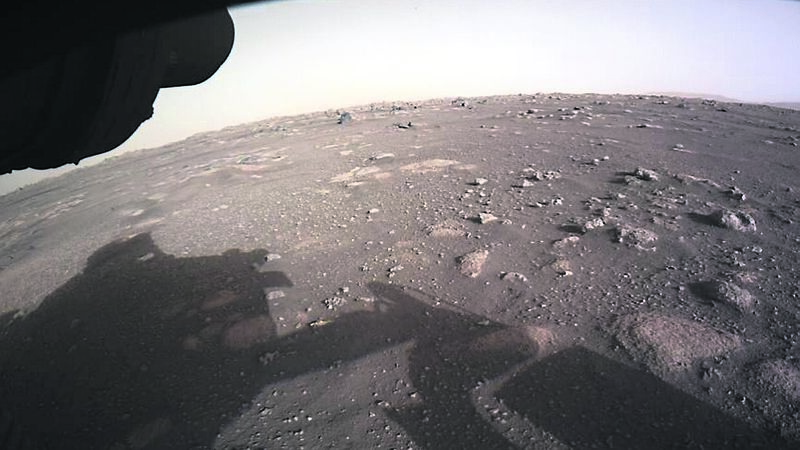Kathriona Devereux: Forget about life on Mars, let’s concentrate on strife on Earth

For a few years in the 1980s, the highlight of my summer was when my next door neighbour would go away on her two-week holiday. This was a very exciting time for our household because while she was away she would lend us her VHS player.
Long before ‘binge-watching’ or the idea of limiting kids’ screen time, myself and my mother would draw the curtains against the sunshine and spend two weeks watching videos that we rented from Xtravision. ET, Indiana Jones, Ghostbusters, Romancing The Stone, Splash, Gremlins, The Karate Kid — we watched them all, repeatedly.
But it was the 1986 movie Space Camp, about a gang of teenagers who, while attending a summer camp at Kennedy Space Centre, are accidentally sent into space, that launched my love of all things space and NASA-related.
The nearest I got to fulfilling that ambition was filming for an RTÉ science show in 2006 when I visited NASA’s Goddard Space Flight Center just outside Washington D.C.
Goddard is home to the Hubble Space Telescope Operations Control Center and Willy Wonka-esque engineering labs where equipment destined for space is tested before launch. The ‘Chamber of Horrors’ shakes, bakes and irradiates space gear to make sure it is able for the rigours of space and the High Capacity Centrifuge subjects space bound equipment to up to 30Gs.

I even got to enter a clean room facility where the latest earth satellite was being constructed. It was so exciting to be up close to something that is now orbiting our planet and I’ve maintained that excitement in the intervening years, enjoying Commander Chris Hadfield’s singing on the International Space Station or following news of space probe Voyager 1 becoming the first human-made object to leave the Solar System.
In 2019, I lapped up the coverage of the 50th anniversary of the lunar landing and marvelled at how brilliant humans are at achieving the ‘moonshot’ with just the computing power of an outdated mobile phone.

Watching the high definition video of the Mars rover Perseverance landing in the Jezero Crater, and the 360 degree image of the surface is, amazing and breathtaking, but it also made me a little sad to think that humanity spends so much time, money and effort going to somewhere 216 million kilometres away when the world we stand on is amid an ecological catastrophe that requires time, money and effort to fix.
And, actually, we don’t really have the luxury of much time anymore — we need to at least halve greenhouse gas emissions in the next nine years.
The argument that $2.7 billion dollars is not really that much, representing just 0.0075% of all spending by the United States government, the box office takings of The Avengers: Endgame movie or how much Google makes every six days, is not really the point. It’s not about the money.
It’s about the fact that so many of the world’s best and brightest minds at U.S, European, Chinese, Russian, Indian, Japanese and Canadian space agencies are dedicating their problem-solving brain-power to work out ways of surviving off the planet at a moment in human history when we really need to work out ways of surviving on the plant.

Whereas NASA’s top priority is to return American astronauts to the Moon by 2024 and to build a sustainable presence there by 2028, it seems to me we need all the human ingenuity we can muster for an ‘earthshot’ to save the planet — not another ‘moonshot’.
There’s a scene in the film Apollo 13 where NASA engineers are tasked with the job of building a carbon dioxide scrubber with a few hoses, socks, filters and gaffer tape, or else the crew members aboard the damaged capsule will suffocate and die.
I’d like NASA to channel the energies of those 1970s engineers to make a carbon dioxide scrubber for the planet. To shelve their lunar ambitions and instead direct their talent towards Earth and for the next ten years transform into NESA — the National Earth Saving Agency.
In their research to maintain life in space by replicating all of our planet’s life-giving essentials, NASA scientists have already amassed so much knowledge about life systems on Earth.
The International Space Station (ISS) has run successful experiments on energy-efficient food production that could transform the polluting ways of agriculture on Earth.
Research on the use of LEDs for plant growth is already saving energy for indoor agriculture. Scientists have also identified a bacteria, Hydrogenomonas, that eats carbon dioxide and outputs proteins and oils that could be used to replace soybeans and palm oil — the production of both have huge environmental impacts and are drivers of deforestation.
Basic space research has given us many transformative technologies such as GPS, weather satellites and dialysis machines over the years.
Even though many climate solutions are nature-based and require humans to simply leave nature alone to renew itself, imagine if NASA dedicated itself to developing transformative technologies for Earth that gave us cleaner air, food and water and helped solve the climate crisis. Mission Earth — I’d like to watch that movie in the future!







 App?
App?




